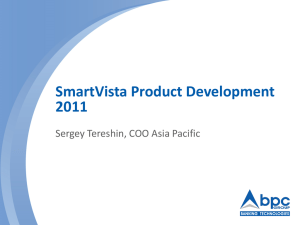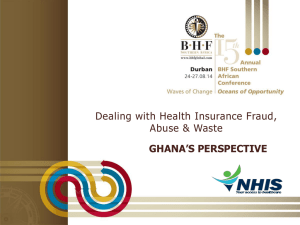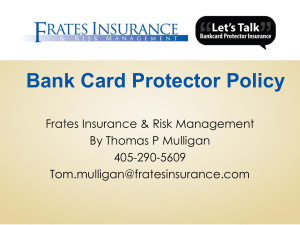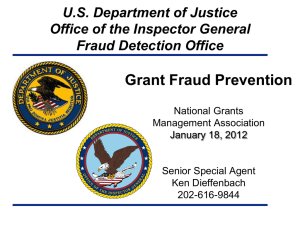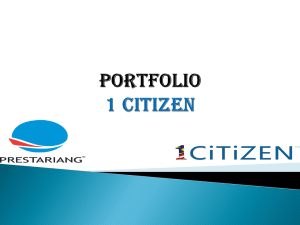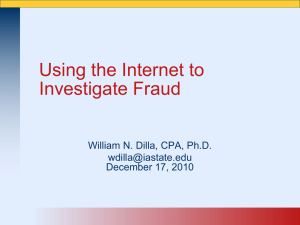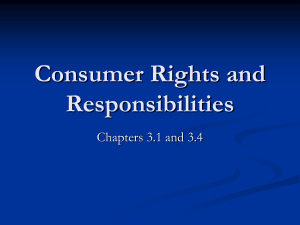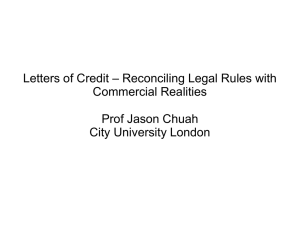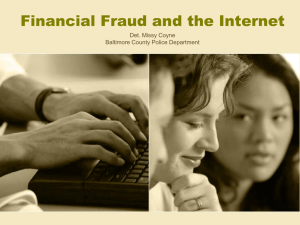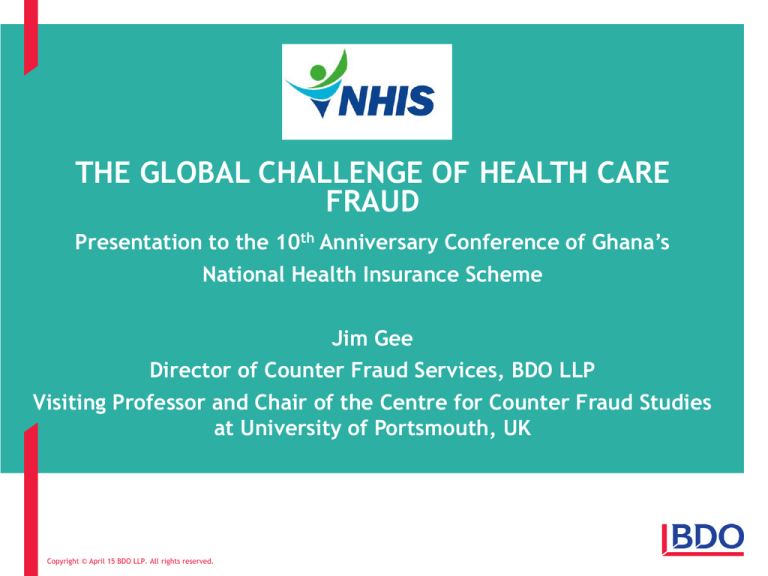
THE GLOBAL CHALLENGE OF HEALTH CARE
FRAUD
Presentation to the 10th Anniversary Conference of Ghana’s
National Health Insurance Scheme
Jim Gee
Director of Counter Fraud Services, BDO LLP
Visiting Professor and Chair of the Centre for Counter Fraud Studies
at University of Portsmouth, UK
Copyright © April 15 BDO LLP. All rights reserved.
WHAT WILL BE COVERED
•
•
•
•
•
•
•
•
•
Background
What is healthcare fraud?
Why is healthcare fraud important?
Why we need to do more to tackle it
A new approach : focussing on fraud as a business cost like any
other
What is the cost of healthcare fraud?
How quickly can the cost of healthcare fraud be reduced?
How can this be done?
How we can work together globally to tackle healthcare fraud
BACKGROUND
28 years a Counter Fraud Specialist
Advisor to UK Parliamentary Select Committee
Chief Executive of the UK NHS Counter Fraud Service
Senior Civil Servant at Department of Health
Director-General of the European Healthcare Fraud and Corruption
Network countries
• Senior advisor to the UK Attorney-General, 3 Secretaries of State and 5
Ministers
• Advised the Chinese and New Zealand Governments on healthcare
fraud and has worked with companies in the UK as well as more than
35 other countries, most recently Zambia, Indonesia, Cameroon and
South Africa
•
•
•
•
•
WHAT IS HEALTHCARE FRAUD?
Let’s be clear …
IT IS DISTINCT FROM
• Corruption or bribery
• Money laundering
LET ALONE
• Error or incompetence
NOT just a criminal matter - a destructive social and economic
phenomena which can be subject to
•
•
•
•
Civil law
Criminal law
Regulatory sanctions
Disciplinary sanctions
WHAT IS HEALTHCARE FRAUD
Four main types of healthcare fraud:
(1) Fraud by managers and staff
(2) Fraud by healthcare professionals
(3) Fraud by citizens and patients
(4) Fraud by contractors and suppliers
FRAUD BY MANAGERS AND STAFF
• Misdirection of resources: One finance
manager was found to have placed their
family on the payroll of the healthcare
organisation that they worked for;
• Personal impropriety: One Chief
Executive Officer of a healthcare
organisation was found to have
overclaimed on his mileage allowance by
55,000 miles;
• Hospitals: Hospitals have been found to
falsely claim that they have undertaken
surgical procedures to attract extra
payments – upcoding and unbundling.
FRAUD BY HEALTHCARE PROFESSIONALS
• Doctors: a Doctor was found guilty of using
bogus herbal medications to offer false hope
to dozens of people suffering from diseases
such as cancer and Alzheimer’s;
• Dentists: Dentists have claimed for gold
fillings which were actually mostly composed
of nickel; and to have claimed fees for reopening their surgeries out of normal hours
without actually doing this;
• Opticians: Opticians have claimed fees for
undertaking sight tests on people who were
subsequently found to have been dead or
non-existent.
FRAUD BY CITIZENS AND PATIENTS
• Organised criminals: criminals establish
bogus medical clinics in order to bill insurers
for healthcare treatments that were never
provided and have stolen confidential
patient data for use in credit card fraud;
• Patients: Patients have lied about their
circumstances in order to obtain free
healthcare treatment, to pretend that they
are resident in particular countries where
they were entitled to free treatment;
• Counterfeit drugs: Thousands of cancer
patients were given fake drugs in a multimillion pound fraud that could have
condemned them to early deaths.
FRAUD BY CONTRACTORS AND SUPPLIERS
• Pfizer Inc., the drugs giant, was ordered to
pay $2.3 billion in America’s largest
healthcare fraud settlement, for making
false claims about four prescription
medications;
• Generic drug companies: Drug companies
have been found to organise cartels to
restrict the supply of key drugs and to
artificially raise the price; they have also
been found paying bribes to medical
professionals to prescribe their drugs;
• Equipment companies have been found to
supply counterfeit diagnostic equipment.
THE WORST EXAMPLES OF HEALTHCARE FRAUD
• In Taiwan three doctors admitted to conspiring with patients to defraud
insurance companies of almost NT$80 million. They had been falsely
diagnosing patients with cancer –performing breast removal surgeries and
chemotherapy in disease-free bodies – to file multiple payment claims.
The Department of Health estimated that more than 10 hospitals were
involved.
THE WORST EXAMPLES OF HEALTHCARE FRAUD
• In Italy eight doctors performed unnecessary
surgery in an attempt to defraud the Italian
health service. The operations included
unwarranted mastectomies and the
unnecessary removal of a lung from a patient
with pneumonia. Pier Paolo Brega Massone, the
head surgeon at Milan’s Santa Rita clinic, was
sentenced to 15 months. He oversaw 80 such
operations. An anonymous tip-off lead to
wiretaps which caught the doctors talking
about earning more from more invasive
surgery. Prosecutors stated that at least five
patients died after operations that were too
risky for their condition. The frauds reportedly
cost the health service £2.2 million.
Pier Paolo Brega Massone
WHAT IS HEALTHCARE FRAUD?
So that is what fraud is – and can be ...
WHY IS HEALTHCARE FRAUD IMPORTANT?
• It is not a victimless crime
• It diverts resources from the provision of quality patient care
• It has a direct, negative impact on human life
WORLD HEALTH ORGANISATION REPORT
Fraud is one of the
‘top ten’ causes of
inefficiency in
healthcare
spending
http://www.who.int/whr/2010/10_chap0
4_en.pdf
PROTECTING INTERNATIONAL HEALTHCARE
• WE NEED TO DO MORE
• We need more investment in healthcare
fraud work
• We need stronger national and international
networks
• We need professional training and
accreditation like any other healthcare
profession
• BUT
• We also need a different approach …
A NEW APPROACH
‘OLD STYLE’ APPROACH
– ‘pay and chase’
– ‘pick & choose’
– Considered enough to
merely do something anything!
– Focused on activities (e.g.
investigations).
– Perceptions based on
anecdotal information or
cases which have come to
light.
– Cannot quantify effects or
track benefits to the
organization.
MODERN APPROACH
– Proactive and
comprehensive.
– Identifies and applies
exactly the right solution.
– Focused on outcomes
(e.g. reduced losses).
– Statistically sound and
legally founded method of
measuring fraud
– Seeks to pre-empt fraud
not just react to it
– Quantifies the reduction in
fraud losses and tracks
tangible financial benefits.
FRAUD LOSS MEASUREMENT
The last 15 years
• In the UK NHS from 1998
‘The Financial Cost of
Healthcare Fraud’ Report
2011’
• US Improper Payments Information Act 2002
• European Healthcare Fraud and Corruption
Declaration 2005
• The UK Government Fraud Review 2006
• US Improper Payments Elimination and
Recovery Act 2010
• ‘The Financial Cost of Healthcare Fraud’
Report 2009, 2011 (and soon 2014)
TO BE UPDATED IN
FEBRUARY 2014
WHAT THE DATA SHOWS
Where has healthcare fraud been accurately
measured?
Our 2011 research shows:
•
Results collated over more than 12 years
from across the world
•
Estimating the total cost of fraud (and error)
•
Statistically valid estimates : 90 – 95%
statistical confidence
•
Accurate : between plus or minus 1 – 2.5%
•
Externally validated
‘The Financial Cost of
Healthcare Fraud’ Report
2011’
WHAT THE DATA SHOWS
•
79 loss analysis exercises in 33 organisations
in 6 countries
•
Value of expenditure where measurement
took place = over US$1.6 trillion (5.6 trillion
Cedi)
•
Excluding any figures based on detected or
reported fraud or ‘guesstimates’ or surveys
of opinion
•
The average loss rate from such a large,
diverse and international study gives a
reliable indication of losses in any
organisation
‘The Financial Cost of
Healthcare Fraud’ Report
2011’
WHAT THE DATA SHOWS
Many different types of healthcare expenditure:
• the fraudulent provision of sickness certificates • prescription fraud by
pharmacists • prescription fraud by patients • fraud and error
concerning capitation payments to doctors • fraud and error
concerning payments made to doctors to manage a patients medical
care • the evasion of dental charges by patients • fraud and error by
opticians concerning the provision of sight tests • fraud and error
concerning employees of healthcare organisations • fraud and error
concerning payments for in-patient hospital services • fraud and error
concerning long term care • fraud and error concerning home and
community based services • fraud and error concerning the provision
of services and supplies, • fraud and error concerning health insurance
for children
WHAT DO THE FIGURES SHOW?
18.00%
16.00%
14.00%
12.00%
10.00%
8.00%
15.40%
6.00%
4.00%
2.00%
7.29%
3.00%
0.00%
LOWEST PERCENTAGE LOSS
AVERAGE PERCENTAGE LOST
HIGHEST PERCENTAGE LOSS
WHAT DO THE FIGURES SHOW?
PROPORTIONS OF DIFFERENT
LEVELS OF LOSS
40.91%
59.09%
PERCENTAGE LOSS 3-8%
PERCENTAGE LOSS > 8%
WHAT DO THE FIGURES SHOW?
8.00%
7.00%
AN INCREASE OF
OVER 30%
6.00%
5.00%
4.00%
7.29%
3.00%
5.59%
2.00%
1.00%
0.00%
AVERAGE PERCENTAGE LOST - BEFORE THE
RECESSION
AVERAGE PERCENTAGE LOST - AFTER THE
RECESSION
GLOBAL LOSSES TO HEALTHCARE FRAUD
What do the figures mean?
• Globally, just in the healthcare sector
US$415 billion (£259 billion / €301
billion) is lost
• Enough to provide clean, safe water
around the globe, bring malaria under
control in Africa, provide the Diptheria,
Tetanus and Pertussis vaccine to all 23.5
million children under one years old who
are currently not immunized (2.5 million
die each year from diseases preventable
by vaccines), quadruple the budget of
the World Health Organisation and
UNICEF (the United Nations Children’s
Fund), with over US$320 billion (£200
billion / €232billion left over!)
HOW QUICKLY COULD THESE LOSSES BE REDUCED?
Examples in “The Financial Cost of Healthcare
Fraud Report 2011”
• Reductions of up to 40% within 12 months
i.e. if the average cost is just under 7.3% of
expenditure then just under 3% of that
expenditure is no longer being lost
• UK NHS – Losses reduced by up to 60% with a
12 : 1 return on the costs of the work
The potential benefits
• healthcare organisations better able to
deliver top quality patient care
‘The Financial Cost of
Healthcare Fraud’ Report
2011’
PROBLEM
HOW CAN THIS BE
ACHIEVED?
THE COMPREHENSIVE
APPROACH
STRATEGY
PRE-EMPTIVE
ANTI FRAUD
CULTURE
DETERRENCE
PREVENTION
STRUCTURE
An organisation
which is resilient to
fraud has all of this
in place
ACTION
DETECTION
INVESTIGATION
SANCTIONS
REDRESS
REACTIVE
DELIVERY
THE IMPORTANCE OF FRAUD RESILIENCE
• The better protected an organisation is the less it will lose to fraud …
• Fraud resilience is a Government accepted measure rooted in the
CIPFA ‘Managing the Risk of Fraud’ standards and developed by BDO
and the Centre for Counter Fraud Studies at University of Portsmouth
• 29 different factors; a maximum rating of 50 points; has been applied
to organisations representing more than 1/5th of UK GDP
• We work with the Centre for Counter Fraud Studies at University of
Portsmouth. We manage the largest database in the world concerning
fraud resilience with data relating to over 700 organisations
• We provide a ‘helicopter view’ of how well an organisation is
protected against fraud, so weaknesses can be identified and removed
and the cost of fraud reduced.
A helicopter view of your organisation
www.safr.bdo.co.uk/fraud
FRAUD LOSSES AND FRAUD RESILIENCE
We have data concerning
the fraud resilience of
more than 700
organisations.
AVERAGE RESILIENCE
AVERAGE LOSS
We have data concerning
more than 290 fraud loss
measurement exercises
involving 40 types of
expenditure with a total
value of over
£7.22 trillion.
• We can see the relationship – in healthcare and
beyond
• The most resilient losing 1.5% of expenditure or less
• The least resilient losing 10% of expenditure or more
CONCLUSIONS
• Healthcare fraud can be measured as a business cost like any other
• More and more organisations recognise the value of doing this
• The data shows that fraud losses are significant – AND RISING
• Research shows they can be reduced by up to 40% within 12
months – if organisations become fraud resilient
• The link between fraud resilience and fraud losses is very clear –
and can be calibrated
• The power of knowledge – practical experience and academic
rigour brought together – can help – but we can also help each
other …
Page 30
CONCLUSIONS
• What we have in common
• What our people want
• None of us are immune
• Fraud drains the lifeblood from our healthcare systems
• Together we can do much more; together we are strong; divided
we are weak.
Page 31
Jim Gee
jim.gee@bdo.co.uk
+44 20 7893 2830
+44 7810 484 111


